Staad Abbey

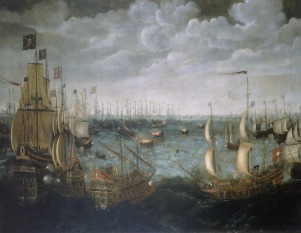
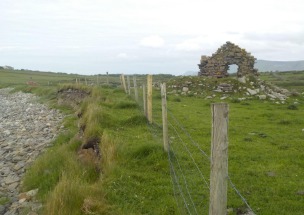
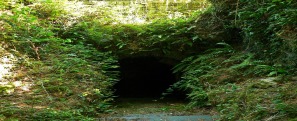

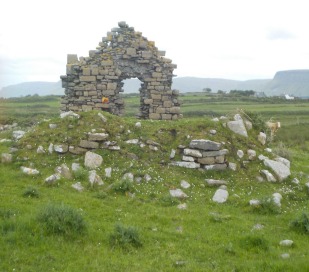
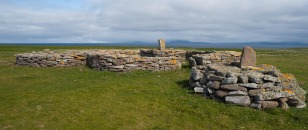
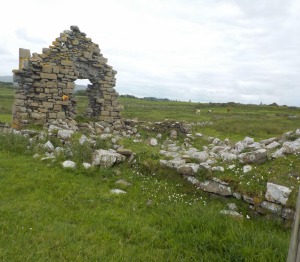

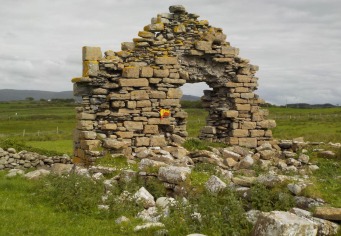
Local History Project
Staad Abbey
By Méabh McIntyre
About Staad Abbey
Staad Abbey is an early monastic site, reputedly founded by St Molaise, where pilgrims and other travellers en route to Inishmurray, (an island just off where Staad Abbey is) would stop off and stay there before getting a boat to the island. It is can also be called a shore hostel, for travellers to stay in. There are also associated features including open air cooking spaces and a possible area of lime production to make mortar. Many items have been discovered around there by archaeologists and local residents, such as two quern stones, a piece of gunflint, evidence of a trackway or platform from the Bronze Age and preserved wooden posts that may have been used to hold nets to trap migrating birds for food. Despite the name, there is no evidence that Staad Abbey is actually an abbey.
Staad Abbey is located in Agharrow, County Sligo, right on the cliff above the beach there, which is very near Streedagh. It is about 6.5km from Inishmurray, which is in the Atlantic Ocean
Staad Abbey, the building
Staad Abbey was built in approximately the late fifth century or early sixth century. It was built by St. Molaise (and some other people, who knows who they were). The reason he wanted to build it
was because he wanted somewhere for monks and pilgrims to stay and pray while they waited for a boat to Inishmurray (which St. Molaise also founded) and it first came into use a few years after it was begun to be built. It measures 12 x 6m (approx). No one really knows when it stopped being used, or why it stopped being used, or when it stopped being used except that it was before 1880. Now, there’s only one wall left and it’s very weak.
Inishmurray and Staad Abbey
Inishmurray is an island about 6.5km from Staad Abbey in the Atlantic Ocean. It is an early monastic site. The monastery there was founded by St. Molaise, (a monk) during the 5th century. There is a statue of St. Molaise in a famous museum in Dublin and a copy in the park in Grange. The island is about 1 mile long and 0.78 miles wide. Since 1948 it has not been lived on.
Staad Abbey was a sort of hostel for travellers on their way to Inishmurray. Travellers used to stay there for a bit until the next boat went. They were mostly pilgrims or monks, so they would pray a lot. Basically, Staad Abbey was a cell of Inishmurray, a very important part of it, as if Staad Abbey didn’t exist no one would be able to go to Inishmurray (unless they owned a boat or could swim very well!). Not anyone really stayed for long, other than the people who lived there and provided food, but they were also monks. So the main thing was Inishmurray, but Staad was definitely a big part of it all. Some say it was a medieval church but really it may date back earlier.
A day at Staad Abbey
The people who stayed at Staad Abbey were
monks. Monks live a very disciplined life. They
have to get up really early in the morning for
prayers. They each had different jobs, such as
taking care of animals, copying books, cooking,
cleaning or gardening. Monks prayed a lot, and
they would have held Mass and done all that
kind of thing. All the things listed above monks
would have done when they were in the
monastery, (in this case, Inishmurray) so life at
Staad Abbey would probably be less disciplined,
but there would be a lot of praying and work still,
probably.
Other Things at Staad Abbey
Shell Midden
Just beside Staad Abbey there is a shell midden. This is a refuse site, made mainly of shells. People would have dug a hole and dumped all their rubbish, which was mainly shells from the shellfish they’d eat. The shell midden can be seen now that the sea has eaten away some of the cliff. People staying there may have eaten lot of other things but they have all broken up and there are no signs of them.
Souterrain
Also at Staad Abbey there is a souterrain, which is an underground passage used for storage and shelter. People would have hidden there, if there was an enemy coming and they would have stayed there until the enemy had gone. Also, they would store food there, (especially meat or fish that had been caught as it would be cooler for them underground).
The shell midden at Staad Abbey. A souterrain, (not the one at Staad Abbey).
Staad Abbey in danger
Staad Abbey is in danger of falling into the sea
because of coastal erosion caused by climate
change. Since the 1830s, approximately 16m of
the land have been taken by the sea, and nearly
a metre between 2012 and 2014, which,
apparently was “a period of bad weather and
heavy storms.” The building now stands
approximately 3.5m at one end, 6.5 at the other
from the cliff edge. If erosion continues, Staad
Abbey will be in the sea. Luckily, archaeologists
are trying to find a way to protect the building,
but they may not be able to, especially as there
is not much time for them to do anything. Staad Abbey is very close to the sea, and is very weak as there is only one of the walls left.
Fransisco de Cuellar and Staad Abbey
A few months after the boat he was on, the
La Lavia, sank on Streedagh Beach, the
Spanish Armada survivor, Fransisco de
Cuellar at one point sought refuge in Staad
Abbey. When he arrived there, in 1588, he
found the church partly burnt and twelve
Spaniards hung from the rafters. De Cuellar
stayed there for a bit, maybe a few weeks,
and then he fled again. Some people say that
it was not Staad Abbey he visited, but some
other medievial church around Staad Abbey,
possibly Ahamlish church, just north of
Streedagh, (where the ships definitely sank). The Spanish Armada, 1588
Different Pictures of Staad Abbey
Another picture of the shell midden
Inishmurray seen from Staad Abbey
Above and left, Staad Abbey
Staad Abbey side-on
Sources
The information was sourced from the following sources: Dr. Fiona Beglane, IT Sligo Applied Archaeology + Jerry O’Sullivan, Galway County Council, January 2 2015. https://rté.ie/news Eileen Magnier, 3 March 2021. Ask About Ireland. Wikipedia.org. https://excavations.ie 2000: 0866 - Staad Abbey.
https://commons.wikimedia.org/wiki/File:Ch%C3%A2teau_de_la_Joyeuse_Garde,_entr%C3%A9e_du_souterrain.jpg is the souterrain photo on slide 6
https://commons.wikimedia.org/wiki/File:Inishmurray_Trahanareear_2015_09_06.jpg is the photo of Inishmurray on slide 4 https://commons.wikimedia.org/wiki/File:Baronies_of_Sligo.jpg is the photo of the map on slide 2
https://commons.wikimedia.org/wiki/File:Spanish_Armada_fireships.jpg is the photo of the Spanish Armada on slide 8 The rest of the photos I took myself.
I hope you enjoyed my presentation!
Staad Abbey by Darragh Gilmartin
Staad Abbey is located in the townland of Agharrow, in the parish of Ahamlish. It is near Streedagh and Grange. On the beach there is very little sand and it is mainly rocks. The name Staad comes from the Latin statio, meaning stage or station because pilgrims stayed at Staad on the way to Inishmurray.
The shell middens came about when the people who lived in the abbey dug a hole and dumped the shells of the shell fish that they ate. You are able to see all the shells because of the sea wearing away the soil.
By Darragh Gilmartin
Last changed: Jun 23 2021 at 5:24 PM

